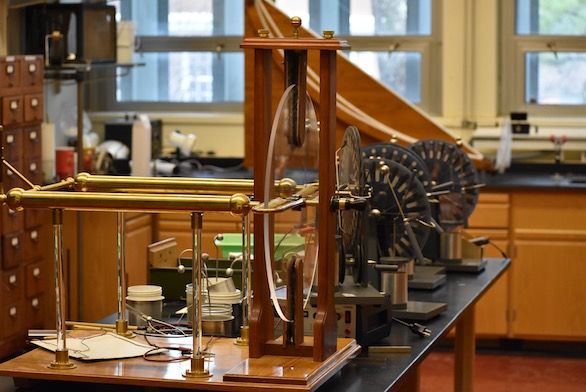More Than a Thought Experiment: The St. John’s Lab Program
March 18, 2020 | By Les Poling

Popular Mechanics recently published a story on the armillary sphere at the St. John’s Santa Fe campus titled “This is the Only Working Armillary Sphere on Earth.” The modern-day reconstruction of Tycho Brahe’s astronomical device, a gift from the Class of 2004 and friends, also received coverage in the Associated Press and Nature Astronomy. The sphere, a work of art in its own right, is a newsworthy example of pioneering science come to life; a monument to innovation and discovery that offers the ability to explore the galaxy from a past perspective.
But for Johnnies, that concept of exploration is nothing new. They’ve been doing it in lab for decades.
At St. John’s, there’s no separation between the humanities and the sciences; they’re considered part and parcel of the same journey through human thought. Therefore, the lab program is designed in the same way as the rest of the Program. Students pursue scientific learning side by side with the arts and humanities, relying on primary texts and replicating experiments to consider fundamental questions that have shaped our perception of the universe, exploring the theories of Huygens, Newton, Einstein, and more.
In freshman lab, students study biology, physics, and chemistry, developing measurement, dissection, and experimentation skills while reading everyone from Archimedes to Pascal. Junior lab focuses on physics, with students designing and recreating experiments using the works of Franklin, Faraday, Maxwell, and more. Senior lab, with its focus on biology, genetics, and physics, investigates living organisms and atomic particles, returning students to the fundamental questions posed in their first year. It’s a curriculum focused on constructive analysis, experimentation, and inquiry. It’s also one that, due to its emphasis on primary sources and replicating experiments, necessitates rare lab equipment, including tools that are often built from scratch by college staff. To complement its one-of-a-kind Program, St. John’s has curated one of the most unique laboratory collections in the country, led by Santa Fe lab director John Balwit and Annapolis lab director Mark Daly.
The lab programs on both campuses provide students with plenty of opportunity to use specialized equipment. In Annapolis, much of it exists thanks to staff member and craftsman Gary Dunkelberger.
“This is where it all happens,” says Daly, referring to the workshop in the basement of Annapolis’s Mellon Hall. Daly has been the lab director at St. John’s Annapolis since 1985, and throughout the decades, he’s been in charge of maintaining and expanding the college laboratories—designing and building storage cabinets, repairing 20th century engines, and fielding requests for new pieces of equipment, among other duties. On a tour through Mellon, he points out piece after piece of rare equipment, most of which have been created by Dunkelberger. Whenever the college requires new or refurbished lab gear, “I come down to the workshop, and I say ‘hey Gary, we need something,’” Daly says. “He’s a real artisan.”
A walk through Mellon almost feels like touring an exhibit of Dunkelberger’s work. But it’s no museum; all these instruments really function. “They’re thought experiments that our shop brings to life,” Daly says. “The students read all these original texts, and we build apparatuses to demonstrate them.”
Dunkelberger has created or restored countless items in the St. John’s labs, including Faraday motors, a stunning Foucault pendulum, camera obscuras, and devices that measure and record the speed of light. “We’re going from quantum mechanics down to little wooden blocks,” Daly explains. But Dunkelberger’s most notable work is easily the college’s Maxwell Machine. “[Years ago,] a tutor came to me with a pencil drawing and said ‘hey, can you make this?’” Daly recalls. “It was a drawing by [Scottish scientist James Clerk] Maxwell.” Maxwell famously formulated the classical theory of electromagnetic radiation, but he never built his sketched design. Using the 19th century blueprint, Dunkelberger finished what Maxwell started, using polished brass and elegantly turned wood. “I looked in the Maxwell museum, I looked everywhere—I think this is the only [Maxwell Machine] on the planet,” Daly says. “We took Maxwell’s thought experiment, his idea, and we made it. And it works really well.”
What Dunkelberger doesn’t build from scratch, he refurbishes, repairs, and elevates to a pristine level of artistry. (The Capital Gazette described his Maxwell Machine as worthy of the Museum of Modern Art.) It’s thanks to Daly, Dunkelberger, and the workshop staff that Annapolis Johnnies can walk in the footsteps of Faraday, Newton, and more.
That being said, the St. John’s lab is in no way antique or obsolete. Stroll through the spacious rooms of Mellon, and you’ll find flat-screen HD televisions and state-of-the-art microscopes equipped with touch-screen display tablets. “It’s all high-tech stuff,” Daly says. “You’d find this at the University of Maryland.” Why the sophisticated machinery? Because, like the rest of the St. John’s Program, the lab equipment used by Santa Fe and Annapolis Johnnies isn’t stuck in the past. It’s designed to help students examine foundational ideas, engage in dialogue, and broaden their capacity to think.
A combination of fundamental and modern; an exploration of the past intended to help students ask and answer the big questions of the future. In that regard, from the Maxwell Machine to the touch-screen microscopes, Johnnies may have one of the most complete scientific educations of all.

